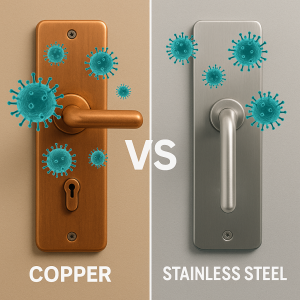
Stainless steel products are prominent in hospitals and public places throughout the United States and the world; however, it may not be the best material option used. In fact, studies show that copper is significantly more antimicrobial than stainless and kills more germs on contact than most all other metals.
Stainless steel is used throughout the hospital including surgery areas, bed rails, handrails, door handles and more. When it comes to having the most sterile environment possible, copper and brasses are the material the medical industry needs to start choosing over stainless steel. Professor William Keevil is a microbiological researcher and Head of Environmental Research at the University of Southampton, United Kingdom and his studies show that the super-virus MRSA simply will not last when in contact with copper, but continues to grow when in contact with stainless steel. This finding is very important, as MRSA is highly contagious!
The U.S. Environmental Protection Agency (EPA) tested this theory and the end result is that the EPA has now registered more than 350 copper alloys with a minimum copper content of 60% as antimicrobial.
The EPA studies show that uncoated copper alloys will kill more than 99.9% of bacteria within two hours of contact to the surface of the copper parts. This will protect patients and hospital workers from various bacteria causing illnesses. It has also been proven through clinical trial research that even tarnished copper won’t change the high effectiveness.
There are a few conditions to keep in mind when it comes to the effectiveness of coppers antimicrobial components. For one, the copper products must never be painted, varnished or covered in any way. The copper must also be cleaned regularly, and they are not registered for use to eat off it or drinking from it.
It is important to remember that when it comes to hospitals, public transportation, schools, shopping centers, care homes, private homes and cruise ships, to name a few common locations with surfaces that are touched by people, parts made out of copper and its alloys should be used for these applications. The medical industry is leaning towards components made out of copper and its alloys as the surfaces of these items are much more effective in killing germs than stainless steel. More and more people in the medical industry are discovering that copper is a highly effective antimicrobial option, which will continue to steer the industry towards a more sterile tomorrow. And as the medical industry turns towards copper, the other industries that can benefit may soon use copper as well. Below are just a few examples of organizations already adopting this material:
Pullman Regional
Sentara Healthcare: Copper-Infused Linens
Copper Door Handles: the new standard
